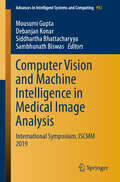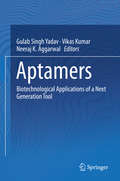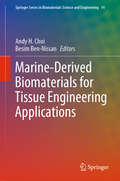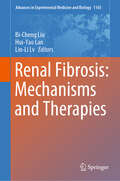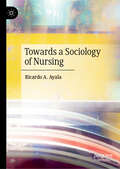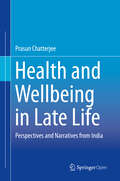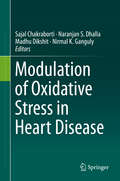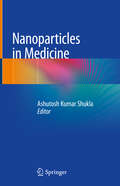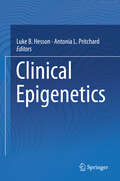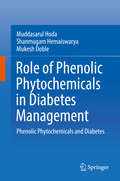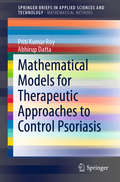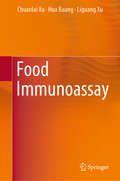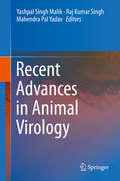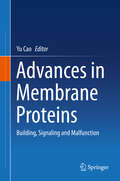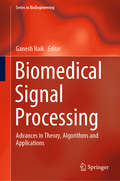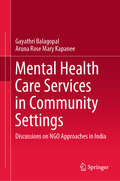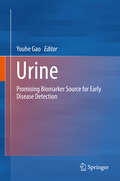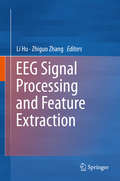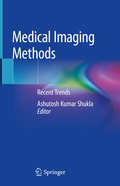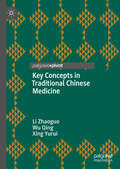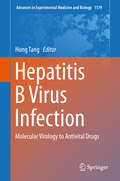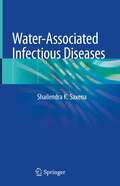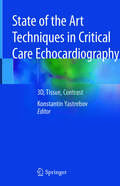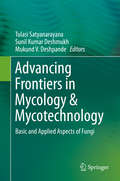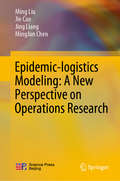- Table View
- List View
Computer Vision and Machine Intelligence in Medical Image Analysis: International Symposium, ISCMM 2019 (Advances in Intelligent Systems and Computing #992)
by Mousumi Gupta Debanjan Konar Siddhartha Bhattacharyya Sambhunath BiswasThis book includes high-quality papers presented at the Symposium 2019, organised by Sikkim Manipal Institute of Technology (SMIT), in Sikkim from 26–27 February 2019. It discusses common research problems and challenges in medical image analysis, such as deep learning methods. It also discusses how these theories can be applied to a broad range of application areas, including lung and chest x-ray, breast CAD, microscopy and pathology. The studies included mainly focus on the detection of events from biomedical signals.
Aptamers: Biotechnological Applications of a Next Generation Tool
by Gulab Singh Yadav Vikas Kumar Neeraj K. AggarwalThe book discusses the basics of aptamers and the advent of aptamer-based technology in recent times. The book covers the diverse applications of aptamers, such as in detection of animal and plant pathogens, disease diagnosis and therapeutics, environmental contamination detection etc. Besides these applications, the book also describes the use of these synthetic or modified DNA, as drug delivery vehicles.The different chapters describe how the binding capacity and specificity of aptamers can be exploited in various ways. The book also discusses how these attributes of aptamers can outdo the antibody technology in biomedical and diagnostic solutions. This crisp and concise book gives the readers an insight into the most recent biotechnological applications of aptamers.
Marine-Derived Biomaterials for Tissue Engineering Applications (Springer Series in Biomaterials Science and Engineering #14)
by Andy H. Choi Besim Ben-NissanThis book presents the latest advances in marine structures and related biomaterials for applications in both soft- and hard-tissue engineering, as well as controlled drug delivery. It explores marine structures consisting of materials with a wide variety of characteristics that warrant their use as biomaterials. It also underlines the importance of exploiting natural marine resources for the sustainable development of novel biomaterials and discusses the resulting environmental and economic benefits. The book is divided into three major sections: the first covers the clinical application of marine biomaterials for drug delivery in tissue engineering, while the other two examine the clinical significance of marine structures in soft- and hard-tissue engineering, respectively. Focusing on clinically oriented applications, it is a valuable resource for dentists, oral and maxillofacial surgeons, orthopedic surgeons, and students and researchers in the field of tissue engineering.
Renal Fibrosis: Mechanisms and Therapies (Advances in Experimental Medicine and Biology #1165)
by Bi-Cheng Liu Hui-Yao Lan Lin-Li LvThis book systemically presents the latest research on renal fibrosis, covering all the major topics in the field, including the possible mechanisms, biomarkers, and strategies for prevention and treatment of chronic kidney disease (CKD). Due to its high prevalence, CKD represents a huge global economic and social burden. Irrespective of the initial causes, CKD progresses to end stage kidney disease (ESKD) due to renal fibrosis, which is characterized by glomerulosclerosis, tubule atrophy and atresia, and the excessive accumulation of extracellular matrix (ECM) in the kidney. Unfortunately, an estimated 1%-2% of the adult population living with CKD will need renal replacement therapy at some point as a result of ESKD. As such, strategies for preventing or slowing CKD progression to ESKD are of utmost importance, and studies aiming to understand the mechanisms of renal fibrosis have been the focus of intensive research. Recently, novel insights into the pathophysiological processes have furthered our understanding of the pathogenesis of renal fibrosis, and more importantly, promoted studies on the early diagnosis and treatment of CKD. This book draws lessons from the extensive, state-of-the-art research in this field, elaborating the new theories and new techniques to offer readers a detailed and comprehensive understanding of renal fibrosis and as well as inspiration for future research directions.
Towards a Sociology of Nursing
by Ricardo A. AyalaTowards a Sociology of Nursing offers fresh insights from recent research into the nursing profession. Nurses represent an important part of the professionally trained female workforce and, being a middle-class profession, changes in nursing reflect changes of many working women worldwide. Scholarship addressing these changes, however, often consists of narratives of nurses talking about themselves, which can be enriched by a sociological background that foregrounds hypotheses.In this book, Ricardo A. Ayala problematises the realities which inform, affect and shape nursing, offering new perspectives on the consequences of those social realities for the nursing profession and society more broadly. He draws on extensive field research with nurses in the workplace, spending time with them, interviewing key actors and reading and analysing documents critically through a distinctive sociological lens.
Health and Wellbeing in Late Life: Perspectives and Narratives from India
by Prasun ChatterjeeThis open access book takes a multidisciplinary approach to provide a holistic understanding of late old age, and situates the aged person within the context of family, caregivers, clinical and other institutions. All through the book, the author discusses preparedness for an aging individual as well as the society in the Indian context. The book highlights inevitable but mostly neglected health issues like depression, dementia, fall, and frailty and provides detailed analyses of solutions that are practicable in low resource settings. It also brings up intergenerational differences and harmony in the context of holistic care of older Indians. Alongside clinical perspectives, the book uses narratives of elderly patients to dwell on the myriad of problems and issues that constitute old age healthcare. Demonstrating cases that range from the most influential to the most underprivileged elderly in India, the book enlightens multiple caregivers—doctors, nurses, and professional caregivers as well as family members—about the dynamic approach required in dealing with complex issues related to late old age. The narratives make the book relatable and interesting to non-academic readers, with important lessons for gerontological and geriatric caregiving. It is also of use to older adults in preparing for active aging.
Modulation of Oxidative Stress in Heart Disease
by Naranjan S. Dhalla Nirmal K. Ganguly Sajal Chakraborti Madhu DikshitThis book highlights the multifaceted roles of Reactive Oxygen Species (ROS) in modulating normal cellular and molecular mechanisms during the development of different types of heart disease. Each chapter in the book deals with the role that altered redox homeostasis plays in the pathophysiology of heart disease. In addition, the book explains how reactive oxidant species interact with their targets and provides novel strategies for attenuating oxidative stress-induced types of heart disease.The book not only covers ROS-induced response in heart disease at the cellular level, but also demonstrates that an imbalance of redox states has its roots in our genes, and explains the ways gene expression is regulated. In turn, it reviews potential sources of ROS, their pathological effects on the heart, and potential sites for therapeutic interventions.
Nanoparticles in Medicine
by Ashutosh Kumar ShuklaThis book describes the medical applications of inorganic nanoparticles. Nanomedicine is a relatively advanced field, which enhances the treatment of various diseases, offering new options for overcoming the problems associated with the use of conventional medicines. Discussing the toxicological and safety aspects associated with medical applications of nanoparticles, the book presents the latest research on topics such as emerging nanomaterials for cancer therapy, applications of nanoparticles in dentistry, and fluoride nanoparticles for biomedical applications, and also includes chapters on the use of nanoparticles such as silver and gold.
Clinical Epigenetics
by Luke B. Hesson Antonia L. PritchardIn genetic pathology, epigenetic testing is rare and under utilised. In this book, we introduce epigenetics to a non-expert scientific audience and describe current and future clinical utility of epigenetic testing. By focussing on epigenetics in human disease this book will guide professionals (scientists and clinicians) to understand how epigenetics is relevant in a clinical context, and to implement epigenetic testing in diagnostic laboratories. The book begins with a historical perspective of genetics and epigenetics and describes the work of pioneers who have helped shape these fields. The various mechanisms by which epigenetics can regulate the function of the genome is described. These include DNA methylation, histone modifications, histone variants, nucleosome positioning, cis-regulatory elements, non-coding RNAs and the three-dimensional organisation of chromatin in the nucleus. These are discussed in the context of embryological development, cancer and imprinting disorders, and include examples of epigenetic changes that can be used in diagnosis, prediction of therapeutic response, prognostication or disease monitoring. Finally, for those wishing to implement epigenetic testing in a diagnostic setting, the book includes a case study that illustrates the clinical utility of epigenetic testing.
Role of Phenolic Phytochemicals in Diabetes Management: Phenolic Phytochemicals and Diabetes
by Muddasarul Hoda Shanmugam Hemaiswarya Mukesh DobleThis book summarizes the latest research trends in phytophenolic therapy for the management of diabetes. It discusses the various mechanisms of action of phytophenolics present in food, fruits and plants that can be used to control/reverse diabetic conditions. Further, it addresses the synergistic interactions of phytophenolics with anti-diabetic drugs, as understanding them can yield valuable insights for complementary and alternative medicine. In closing, it discusses the important aspects of nanotechnology-based targeted delivery and improving the bioavailability of phenolic phytochemicals, two major areas of research in phytotherapy of diabetes.
Mathematical Models for Therapeutic Approaches to Control Psoriasis (SpringerBriefs in Applied Sciences and Technology)
by Priti Kumar Roy Abhirup DattaThis book discusses several mathematical models highlighting the disease dynamics of psoriasis and its control. It explains the control of keratinocyte concentration through a negative feedback mechanism and the effect of including a realistic time delay in that system. The effect of cytokine release is described in a mathematical model of psoriasis and further elucidated in two different mathematical pathways: the ordinary differential equation model system, and the fractional-order differential equation model system. The book also identifies the role of CD8+ T-cells in psoriasis by investigating the interaction between dendritic cells and CD8+ T-cells. Presenting an approach to control the fractional-order system to prevent excess production of keratinocyte cell population, the book is intended for researchers and scientists in the field of applied mathematics, health informatics, applied statistics and qualitative public health, as well as bio-mathematicians interested in the mathematical modeling of autoimmune diseases like psoriasis.
Food Immunoassay
by Chuanlai Xu Hua Kuang Liguang XuThis book systematically covers immunoassays for food, presenting detailed approaches such as antigen design, food matrix pre-treatment and detection format optimization for 9 classes of food hazards and nutrition constituents. Offering ideas on how to improve the efficiency of recognized xenobiotics and food contents, this practical book also describes the discovery and utilization of novel immune agents like aptamer and molecular imprinted polymers in food analysis. It is intended for a broad range of areas, including biologists and food chemists, and is sure to become a key reference resource for students and professionals alike.
Recent Advances in Animal Virology
by Yashpal Singh Malik Raj Kumar Singh Mahendra Pal YadavThis book discusses the prominence and implication of the viral diseases that are a major threat to animals around the globe. A number of these diseases have also shown links with human populations, which has implications for public health. This book offers detailed and up-to-date information on viral diseases in livestock and poultry that were and/or are still a problem. Including cutting-edge developments, it also highlights several landmark contributions in the field of virology from India. Additionally, the book features tables and figures showing important clinical data and recommendations, with references for further information. It also explores the economic impact of viral diseases for farmers and the livestock industry, providing several examples. Further, it presents the latest information on viral diseases in global context, with a focus on state-of-art, molecular tools for the development of diagnostics, prophylactics and therapeutics. Lastly, the book also describes the challenges posed by the emerging and transboundary viral infections and our preparedness to counter them.
Advances in Membrane Proteins: Building, Signaling and Malfunction
by Yu CaoThis book reviews recent advances regarding the biochemical and biophysical properties of membrane proteins and their applications in biomedicine. Divided into two thematic parts, this second volume addresses proteins’ formation, signaling and malfunctions. It covers a number of important membrane proteins including receptors, cell adhesion molecules, single-transmembrane proteins and viral membrane proteins, and discusses their structures, functions, related diseases, and roles in drug discovery in detail. In turn, the book elucidates the lifecycle of membrane proteins, including their synthesis and facilitated folding process, as well as QC procedures for their production. Additional topics include fundamental concepts, the latest findings, and critical puzzles yet to be solved. Given its scope, the book will appeal to a broad readership in the field of membrane structural and functional biology. Junior scientists can use it as an introduction to the field, while advanced scientists will find a broader view of the field beyond their area of specialization.
Biomedical Signal Processing: Advances in Theory, Algorithms and Applications (Series in BioEngineering)
by Ganesh NaikThis book reports on the latest advances in the study of biomedical signal processing, and discusses in detail a number of open problems concerning clinical, biomedical and neural signals. It methodically collects and presents in a unified form the research findings previously scattered throughout various scientific journals and conference proceedings. In addition, the chapters are self-contained and can be read independently. Accordingly, the book will be of interest to university researchers, R&D engineers and graduate students who wish to learn the core principles of biomedical signal analysis, algorithms, and applications, while also offering a valuable reference work for biomedical engineers and clinicians who wish to learn more about the theory and recent applications of neural engineering and biomedical signal processing.
Mental Health Care Services in Community Settings: Discussions on NGO Approaches in India
by Gayathri Balagopal Aruna Rose KapaneeThis book discusses approaches used by NGOs in formulating and implementing mental health care in the community in the context of high treatment gap, insufficient public expenditure on health, human resource shortages, heterogeneity of communities as well as cultural beliefs in India. It uses a qualitative case study approach to document and analyse the work of some major NGO-run community mental health programmes in India, all of which cater to vulnerable populations and are in different and diverse regional settings. It casts the spotlight on envisioning community mental health in policy and law, implementation by the government, how it is practised by select NGOs and the challenges involved in programme implementation. In doing so, it hopes to understand the trigger factors that have led to NGOs embarking on community mental health programmes: how needs of the community are understood, the funding mechanisms, how the human resource gap was addressed, type of networks formed in the community, therapeutic and social interventions, accountability mechanisms, achievements and limitations of the programmes. This book is for students and researchers in the fields of social work and psychology, and NGOs, government and funding agencies, and for those interested in understanding and working with community mental health programmes.
Urine: Promising Biomarker Source for Early Disease Detection
by Youhe GaoThis book demonstrates the potential of urine as a biomarker resource for early disease detection, covering the related theory, strategies, tools and findings. Biomarkers are measurable changes associated with diseases. Blood, as a critical part of its internal environment, is closely monitored and controlled by the body to maintain homeostasis, especially in the early stages of diseases. In contrast, urine, as a form of waste excreted by the body, collects a variety of substance changes. Accordingly, urine can offer an ideal resource for early biomarker discovery. In addition, urine is more stable than blood in vitro, and is easy to store and analyze. The book discusses exciting preliminary applications of urine biomarkers for diseases affecting major biological systems. Its main goal is to make scientists, clinicians and medical companies aware of this important, exciting, undeveloped, and profitable field.
EEG Signal Processing and Feature Extraction
by Li Hu Zhiguo ZhangThis book presents the conceptual and mathematical basis and the implementation of both electroencephalogram (EEG) and EEG signal processing in a comprehensive, simple, and easy-to-understand manner. EEG records the electrical activity generated by the firing of neurons within human brain at the scalp. They are widely used in clinical neuroscience, psychology, and neural engineering, and a series of EEG signal-processing techniques have been developed. Intended for cognitive neuroscientists, psychologists and other interested readers, the book discusses a range of current mainstream EEG signal-processing and feature-extraction techniques in depth, and includes chapters on the principles and implementation strategies.
Medical Imaging Methods: Recent Trends
by Ashutosh Kumar ShuklaThis book provides insights into current radiology practices in diagnostic imaging, discussing specific features of individual imaging techniques, such as sensitivity, specificity and accuracy and signal-to-noise ratio. It includes chapters on various established imaging methods as well as emerging methods such as EPR imaging, and their applications in the diagnosis of skin cancer, brain tumors, oral diseases and kidney cysts. Adopting a bottom-up approach and presenting the recent trends in a simple manner with the help of examples, the book appeals to a wide audience, including academics, researchers, medical and nursing students, as well as healthcare professionals in the field of imaging and radiology.
Key Concepts in Traditional Chinese Medicine
by Li Zhaoguo Wu Qing Xing YuruiThis book offers a comprehensive overview of Chinese medicine terminology translation, defining the most central concepts in Chinese traditional medicine, providing simplified Chinese characters, Mandarin Pronunciation in pinyin, citations for 111 of the most key concepts in traditional Chinese medicine and culture. Covering definitions of terms relating to essence, qi, yin-yang theory, five elements and visceral manifestation in traditional medicine, it offers a selection of English versions of each term in addition to a standard English version, drawing on the translation history of traditional Chinese medicine. It provides a useful resource to understand the fundamental terms of traditional Chinese medicine and culture in Chinese and English, and their relevance to cross-cultural discourse.
Hepatitis B Virus Infection: Molecular Virology to Antiviral Drugs (Advances in Experimental Medicine and Biology #1179)
by Hong TangThis volume provides a state-of-the-art review of the key aspects of HBV. It covers our current understanding of the HBV genome and lifecycle, liver-enriched factors in the regulation of HBV transcription and translation, HBV protein structures and biological functions, and the immunology and pathogenesis of HBV. It also provides an update on cell and animal models, as well as molecular approaches. The respective chapters also cover the clinical management of hepatitis B and discuss future research directions, in particular, the identification of molecular targets for pharmacological intervention. Given its scope, the book offers a valuable resource for students, researchers, clinicians, and health practitioners in the fields of virology, infectious disease, public health etc. Dr Hong Tang is a Professor and Director of the Center of Infectious Diseases, West China Hospital of Sichuan University.
Water-Associated Infectious Diseases
by Shailendra K. SaxenaThis book provides a comprehensive overview of the different water-associated infectious diseases and their linked pathogens with plausible strategies for their mitigation. Although, we are in the era of 21st century having most of the advanced technologies at hand, yet water-associated infectious diseases are the major contributors towards the worldwide morbidity and mortality. The book also focuses on the various implementation strategies of sustainable hygienic conditions, discusses the robust, and reliable policies and strategies on a global aspect to provide unprivileged people access to the basic sanitation, hygiene and water. In addition, the book discusses the possible indirect effect of global warming on the spread of infectious diseases through the distribution of associated vectors.
State of the Art Techniques in Critical Care Echocardiography: 3D, Tissue, Contrast
by Konstantin YastrebovThis book covers all aspects of modern techniques used in the rapidly developing field of adult critical care echocardiography, 3D transthoracic and transesophageal echocardiography, myocardial tissue velocity and deformation assessment, and contrast echocardiography. Featuring multiple color illustrations and echocardiographic images, it provides essential information on the technical aspects and current specifics of the equipment, anatomical imaging guidance, and physiological and pathological approaches with a focus on critically ill population. This book helps practitioners to not only understand the techniques and the applicability of these new technologies in various disease states, but also to apply them in a clinical setting. 3D echo, tissue deformation and contrast are opening tremendous new horizons for intensive care practitioners, offering them previously unimaginable insights into cardiac mechanics and anatomy and using non-invasive approaches for central hemodynamic diagnostic and monitoring management of intensive care patients. It also opens the way for completely new areas in clinical research. This book is useful for intensive care physicians, cardiologists, anesthesiologists, emergency physicians and sonographers involved in the provision of advanced echocardiographic services in intensive care units and in critical care environments. It is also suitable for students undertaking a Diploma of Diagnostic Ultrasound (Critical Care) with the Australasian Society of Ultrasound Medicine, adding to the existing literature used to prepare for the second and third parts examinations.
Advancing Frontiers in Mycology & Mycotechnology: Basic and Applied Aspects of Fungi
by Tulasi Satyanarayana Sunil Kumar Deshmukh Mukund V. DeshpandeThe book provides an introduction to the basics of fungi, discussing various types ranging from edible mushrooms to Neurospora – a model system for genetics and epigenetics. After addressing the classification and biodiversity of fungi, and fungi in different ecological niches, it describes the latest applications of fungi, their role in sustainable environments and in alleviating stress in plants, as well as their role in causing plant and animal diseases. Further chapters explore the advances in fungal interactions research and their implications for various systems, and discuss plant-pathogen interactions. The book also features a section on bioprospecting, and is an extremely interesting and informative read for anybody involved in the field of mycology, microbiology and biotechnology teaching and research.
Epidemic-logistics Modeling: A New Perspective on Operations Research
by Jing Liang Jie Cao Ming Liu MingJun ChenThis book is the first work to conduct the emergency logistics optimization problem under the epidemic environment (whether natural or man-made), which provides a new perspective for the application of optimization theory. In this book, the research methods involve epidemic dynamics, scenario-based emergency decision-making method, big data which combines the traditional and emerging technologies. The authors take epidemic outbreak as the research object and deeply integrate the epidemic spread model with the optimization model of emergency resource scheduling, which opens up a novel application area of operations research.
